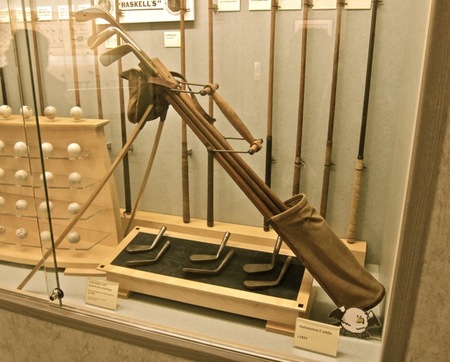When you come to think of it that is the secret of most of the great holes all over the world. They all have some kind of a twist. C.B. MACDONALD
Where The Turf Meets The Turf: Musselburgh Golf & Racing
/Ike: "Golf was essential to his daily routine."
/Barack Obama played his first round of golf since August but after reading Evan Thomas' golf.com excerpt from Ike's Bluff, the President has a long way to go when it comes to matching the Oval Office's greatest golf nut.
 We all know about President Eisenhower's 800 rounds, but there was all this...
We all know about President Eisenhower's 800 rounds, but there was all this...
Golf was essential to his daily routine. When he awakened in the morning, he limbered up by taking a few swings in his bedroom with his favorite eight-iron.
He sometimes swung the club when dictating to Mrs. Whitman. At 5:00 p.m. he would rise from Teddy Roosevelt’s old Navy Department desk in the Oval Office, put on his golf shoes, and head out the door, leaving tiny spike holes in the floorboards. On the Ellipse, the greensward stretching south from the White House toward the Washington Monument, he would practice fairway approach shots. His faithful valet (or as he was known in military parlance, his striker), Sergeant John Moaney, would shag the balls while tourists peered through the iron fence.
Before There Was Instagram...
/"They fly across oceans. It's grand, which is what describes the shot."
/The hate mail has been rolling in over the use of double eagle to describe Louis Oosthuizen's 2012 Masters final round 2 at No. 2. As a maker of a 2 on a par-5 (like how I slipped that in, Johnny Miller style?), I can say that I've never once called it an albatross, and the historical record would seem to suggest double eagle has been part of the golf lexicon longer than albatross.
But as Doug Ferguson points out in this weekly AP notes column, double eagle really doesn't make sense since technically it's four-under par.
It's known as an "albatross" everywhere but in the United States, no doubt because of Sarazen, yet Sarazen once referred to his shot as a "dodo," and so the mystery continues.
"I didn't know what a double eagle was until I came to the U.S.," Geoff Ogilvy once said. "Maybe they couldn't think of a word for something better than an eagle, so they called it double eagle. But it's not really a double eagle, it's an eagle-and-a-half."
Scoring terminology went to the birds long ago.
According to the "Historical Dictionary of Golfing Terms," the word "birdie" came from the American slang of something special. The story goes that three men were playing the par-4 second hole at The Country Club in Atlantic City, N.J., when Ab Smith's second shot stopped inches from the hole and he called it a "bird of a shot." That led to a shot one under par being called a birdie. That was in 1903.
Thus began the use of birds in scoring, such as an eagle, and so "albatross" makes sense.
"It's a good bird, isn't it?" Ogilvy said. "They fly across oceans. It's grand, which is what describes the shot."
Must See Video: Hogan At Augusta
/ There's no direct link, so just go to the Masters.com video page and look for the black and white video with Ben Hogan (you can also search videos by players, a new handy feature).
There's no direct link, so just go to the Masters.com video page and look for the black and white video with Ben Hogan (you can also search videos by players, a new handy feature).
Many great things to look for in the video, including Ken Venturi's voiceover, Hogan's overall cooperative spirit and the clubhouse area pre-1950.
But my favorite bit came at Amen Corner where the creeks are at their rustic zenith and we see remnants on 13 of MacKenzie's old "scab" bunkers.
"This Buried Lie Could Change Golf History"
/Video From The Australian Open Heritage Exhibit
/The Australian Golf Heritage Society has a booth in the tournament's exhibition area where master clubmaker, repairer and student Ross Baker is making a club over the course of the tournament days. I shot some video while he talked about putters...
Another Reason Four Majors Is Enough
/“People may not remember the name Lon Hinkle, but they know the Hinkle Tree."
/Golf As It Should Be Files: Kingarrock
/Nearly two years ago I vowed to profile more of the great, perhaps unsung places in golf and I've failed miserably since that initial post on Santa Anita Golf Course.
But with the holidays looming and the news drying up, it's a nice time to highlight a very special place. It's been an amazing year for me, with stops in Pebble Beach, St. Andrews, Churchill Downs and many other great spots, yet no day brings back fonder memories than a late afternoon round at Kingarrock.
Wooden's Scorecard Found...In His Desk!
/Flashback: Fans In Bunkers
/While the below images show fans in bunkers during tournament play, none were as on top of players and masking bunker boundaries as what happened with Dustin Johnson.
From Rob Matre, Tiger in 2008 at Torrey Pines.
And from the old magazines, courtesy of the art department.

"Sports Illustrated called Snead's 59 'the greatest competitive round in the history of the game.'"
/Nice note from Bob Harig this week on a forgotten 59 by Sam Snead at, you guessed it, the Greenbrier in 1959.
It doesn't count in the PGA Tour record book because the event was not a tour-sanctioned tournament. But it got plenty of attention nonetheless.
According to West Virginia's Register-Herald, Snead shot 59 on May 16, 1959 at the Greenbrier Open, a pro-am event staged at the annual Spring Festival at the Greenbrier.
Snead played alongside three amateurs and Robert Harris, the director of golf and recreation at the Greenbrier. Harris noted that at the time that Snead "did what no one thought was possible. He shot a 59 in a competitive event on a championship golf course during the Greenbrier's annual Spring Festival pro-am.
"Although the PGA Tour does not recognize the feat in their record books, the world recognizes that Sam was the first golfer, either professional or amateur, to achieve that goal."
Sports Illustrated called Snead's 59 "the greatest competitive round in the history of the game."
Snead did shoot 60 in an official PGA Tour event, one of 24 recorded overall. He became the seventh player to do so, accomplishing the feat at the 1957 Dallas Open at Glen Lakes Country Club.















